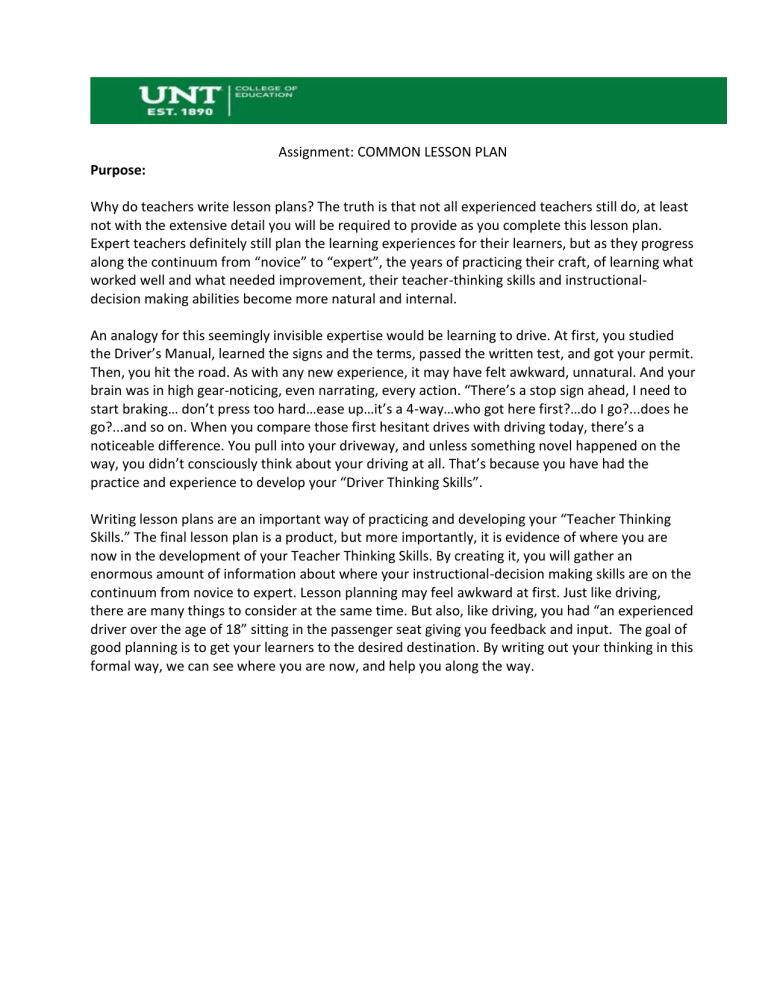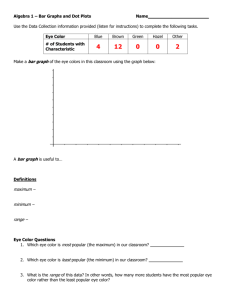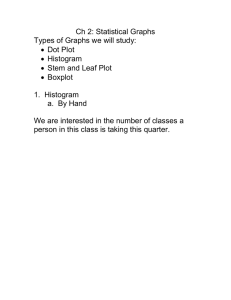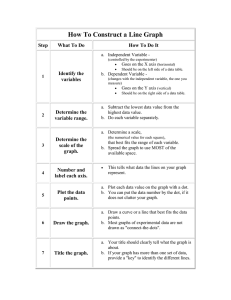
Assignment: COMMON LESSON PLAN Purpose: Why do teachers write lesson plans? The truth is that not all experienced teachers still do, at least not with the extensive detail you will be required to provide as you complete this lesson plan. Expert teachers definitely still plan the learning experiences for their learners, but as they progress along the continuum from “novice” to “expert”, the years of practicing their craft, of learning what worked well and what needed improvement, their teacher-thinking skills and instructionaldecision making abilities become more natural and internal. An analogy for this seemingly invisible expertise would be learning to drive. At first, you studied the Driver’s Manual, learned the signs and the terms, passed the written test, and got your permit. Then, you hit the road. As with any new experience, it may have felt awkward, unnatural. And your brain was in high gear-noticing, even narrating, every action. “There’s a stop sign ahead, I need to start braking… don’t press too hard…ease up…it’s a 4-way…who got here first?…do I go?...does he go?...and so on. When you compare those first hesitant drives with driving today, there’s a noticeable difference. You pull into your driveway, and unless something novel happened on the way, you didn’t consciously think about your driving at all. That’s because you have had the practice and experience to develop your “Driver Thinking Skills”. Writing lesson plans are an important way of practicing and developing your “Teacher Thinking Skills.” The final lesson plan is a product, but more importantly, it is evidence of where you are now in the development of your Teacher Thinking Skills. By creating it, you will gather an enormous amount of information about where your instructional-decision making skills are on the continuum from novice to expert. Lesson planning may feel awkward at first. Just like driving, there are many things to consider at the same time. But also, like driving, you had “an experienced driver over the age of 18” sitting in the passenger seat giving you feedback and input. The goal of good planning is to get your learners to the desired destination. By writing out your thinking in this formal way, we can see where you are now, and help you along the way. UNT COMMON LESSON PLAN INSTRUCTIONS Teacher Candidate: Tyler Layman, Yizheng Zhang Grade Level and or Subject: 5th grade Mathematics Date:2/5/2020 Unit Topic (if applicable):Data analysis PART I. DEFINE THE GOALS/S FOR THE LESSON What is the focus of this lesson? This lesson will explore Data Analysis. Students will demonstrate how to gather data and convey that data onto a bar graph, frequency table and dot plots. National / State Learning 5.9.Data analysis. The student applies mathematical process Standard/s: standards to solve problems by collecting, organizing, . displaying, and interpreting data. The student is expected to: **Your instructor will tell you (A)represent categorical data with bar graphs or frequency which standards to use in tables and numerical data, including data sets of measurements addition to TEKS and ELPS. in fractions or decimals, with dot plots or stem-and-leaf plots; (C)solve one- and two-step problems using data from a frequency table, dot plot, bar graph, stem-and-leaf plot, or scatterplot. Goal/s of the lesson Students will be able to understand and interpret data that has been given to them. In doing so, students will represent that data by means of frequency tables, dot plots and/or bar graphs using only whole numbers. PART II: WRITE THE OBJECTIVE/S FOR THE LESSON Specific learning target(s) / Given the definition of the bar graph, dot plot and the objectives: frequency table, students will be able to identify, collect, organize, display, and interpret data with 80% accuracy. Given the example of the bar graph, students will be able to represent the data in the bar graph with 85% accuracy. PART III TEACHING THE LESSON This is the body of the lesson plan. Here you explain the instructional and learning activities/actions that will best ensure all learners will successfully achieve the objective/s? ****For this section only, you may use the format prescribed by your course instructor, cooperating teacher, or what is required in your field placement. (e.g.: 5E, Madeline Hunter, Inquiry Cycle, etc.) Regardless of format selected, you MUST address components A-F: A. Opening/Introduction Engagement (7mins) Students will be working in groups of five or six. Each group will be given a worksheet with pictures on it and asked to count and group the different pictures on the page. The student will then recorde the different images. When the entire group completes the activity, they will say” Winner winner chicken dinner”. Then the group will win the prizes. B. Procedures ** Include enough detail so that someone else could replicate your lesson. Unless your instructor directs you otherwise, this section should read almost like a script. Explore (10 mins) ---”Building connection” The teacher will read the exploration activity instruction to the students. The students will stay in the same group, and they will have color cubes. Students will match the number of the color cube with the image number that they have counted in the engage activity. After they finish matching the color cube with the image such as key, fish etc. they will regard the data to answer the questions. ● Which image has the largest number? The tree has the largest number. ● Which image has the smallest number? The umbrella has the smallest number ● Based on the data in your group, how could you arrange them? Then the data will look more organized. Students may put the number cubes in orders, so they will have the visual “Bar graph ” Explain1-Station exercise(10mins)--(Appendix A ---Station picture) Teachers have prepared 3 stations and each station will have a graph and 1or 2 questions, so students will be able to come up with their own ideas about the bar graph, dot plot, and Frequency table. Students will keep in the same group, and they will start to walk around and to analyze the poster and answer the questions. Teacher: Now, we have built the data connection with the color cubes, so we will start to learn today’s learning objective. You will stay in the same group, and when I say “Let’s go”, you will quietly stand up and walk to the station(white, blue, and red). You will first start the color the same as your group card. Then you will have 2 mins to stay and answer the questions. After that, you will quietly move to another station. When you finish all the stations, you will go back to your seat. Red Station-Frequency Table Question: How many elements in the Frequency table? Is the date more visualized? Blue station-Dot plot Question: How could you know which one has the largest number? What do you think the dot represents? White Station- Bar Graph Question: Which day has the largest number of packages? After students complete the station activity, the teacher will find a volunteer to answer questions. Blue Station-Frequency Table Question: How many elements in the Frequency table? Is the date more visualized? - 10 elements are in the frequency table and we have 10 numbers. - I think that data is not visualized compared to the bar graph. Red station-Dot plot Question: How could you know which one has the largest number? What do you think the dot represents? - I count the dot, so the line that has more dot will have the largest amount of the fish. - The number line 21 is the largest number, so it represents the largest length of the waldo’s fish. White- Bar Graph Question: Which day has the largest number of packages? How many more packages do Wednesday have than Monday? - Wednesday Explain 2 (10mins) Students will head back to their seats after completing the Station exercise. We will then move to vocabulary and explaining and showing what frequency tables, dot plots, and bar graphs are. The teacher will present a slideshow from a powerpoint that has examples of each of these items. The teacher will guide questions for students to answer, I.E. Question-What does this chart represent? - the data and the number of times each thing occurred. Question- How are the dot plots and bar graphs similar? How are they different? - Dot plots and bar graph, graph the same data that is collected, but they do it by representing it in different ways. Students will be shown how to gather data and input that data into a frequency table. The students will be asked to write down in their journals each definition that is presented. Students will then be shown how the data they gathered can be plotted into a dot plot system, and they will have to record this as well in their journals/notes. Students will then learn how to take the same exact data and plot that data into a bar graph. The students will be asked guided questions to ensure they understand the topic at hand. Question- Did the data change from graph to graph or did it stay the same? - Stayed the same Question- What would happen if we wanted to plot an 8th goal, what process would we take and how would we find that data? - We would have to look for the 8th goal data and then input that data into the chart, then graph it according to the data. Students will be asked to put these handouts into their journals/notepads for future reference and then we will move to the Elaborate. Elaborate(15mins) Students will work as a group of 4 on their worksheet to complete the Garcia Family’s bill questions. Then they will be able to discuss the questions. They will answer the questions and share them with the class. Let’s Share - How did you organize the information? Our group put the information in the table chart, so we could organized the bill information - Which graph that you will choose to use? why? I will use a bar graph. The bar graph will better illustrate which month the Garcia family has more cost for the bill. - Which month does the Gracia family spend more money on the electricity bill? the second/ February - How many steps have you used to solve the problem? Explain? 1. Organized the data in the table 2. Find the x-axis and y-axis and name them 3. Know the interval of the x-axis and y-axis 4. Using a bar to represent the data. Regarding students’ responses, the teacher will ask the student what information in the bar graph will tell you how to save money for the Garcia family? The main energy usage in her family is Heating, Lights, Washer/Dryer, Refrigerator, and TV. Therefore, according to the coordinate grid information, I know that the 5,6,7 month has low electric bills because they do not need to use heating in the summer. C. Formative assessment methods/tools: D. Grouping structure/s: During the Explore activity, the teacher will walk around and ask each group questions to see if they understand the process. ● students know how to count the numbers. ● students know how to compare the data ● students know how to organize the data. During explanation 1, the teacher will ask students questions and let them explain. ● Student will know what is the largest number and what is the smallest number ● Students will know the x-axis, the y-axis. The elaborate will be a formative assessment because the teacher will ask the individual group questions and check their understanding of the bar graph, frequency table and dot plot. ● Engage- groups of 5 that will work on gathering data. ● Explore- Same groups work on representing that data with cubes, and students answer given questions. ● Explain 1- Students breaking into groups of 5 and work on the “Station Exercise”. Students answer questions at each station. ● Explain 2- Teach goes over vocab. and explains what a frequency table, dot plot, and bar graphs are and gives examples of each. ● Elaborate- Real world problem so the students can relate the material to real life, students follow along and help answer questions while being guided to the right answers. ● Evaluate- Students are given an exit ticket to complete before class has ended and is taken up by teacher to check assessment of the lesson and topic. E. Accommodations/ Modifications - - F. Instructional Materials, Equipment and Technology: ● ● ● ● ● ● ● ● ● Students will be placed in groups based on their language proficiency. The ELs will receive more help from the teachers during group e. If students finish the practice question, they can start to work on another question. Poster boards for Station exercises Projector Journals/notebooks Markers/pencils PowerPoint Real World Problem worksheet Engage Worksheet Math Cubes Exit Ticket IV ASSESSMENT THINK: HOW WILL I ENSURE THE LEARNERS HAVE MET THE OBJECTIVE/S FOR THE LESSON? Assessment: 10 minutes Students will be given an Exit Ticket as we finish the lesson to demonstrate they understand data analysis. The students will be questioned on line plots and bar graph pulled from older STARR tests questions. Assessment Accommodation s& Modifications Students will be allowed to work with partners or individually. Students who struggle with comprehension and understanding can use their peers to help guide them to the answers. Reflection V. REFLECTION ON THE EXPERIENCE Write a brief reflection on what worked in the lesson and what you could improve upon for the next lesson. (If you did not actually get to teach it, reflect on your planning experience. What challenged you? What do you still need to know? How could you find out?) TEKS: Texas Essential Knowledge and Skills ELPS: English Language Proficiency Standards CCRS: College Career and Readiness Standards IEP: Individualized Education Plan BIP: Behavior Intervention Plan ELL: English Language Learner Appendix A ---Station picture Appendix B -- Real-world problem Appendix C- Exit Ticket https://tea.texas.gov/sites/default/files/2019_staar_gr5_mathematics_test_2.pdf



